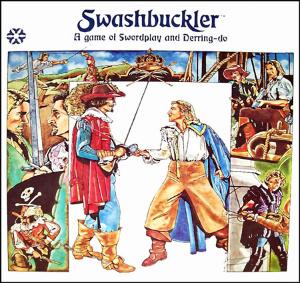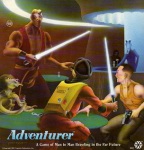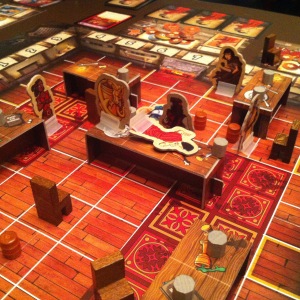Designers: Geoff, Brian & Sydney Englestein
Publishers: Stronghold Games
Players: 2-8
Time: 60-90 minutes
Ages: 12+
Times Played:7 (with review copy provided by Stronghold Games)
Hail and well met, young adventurer! Sit, grab a pint and let me tell you a tale of long ago, of the times of yore… back when Avalon Hill was still its own sovereign kingdom and the only European games any of us knew were Clue and Risk. (Truth be told, we didn’t even know those games were European - we pretty much thought that the Parker Brothers invented them.)
It was the Year of Our Lord, nineteen hundred and eighty… the year of the Miracle on Ice, the release of Pac-Man, and the summer that the Empire finally struck back. Those were heady times, my young friend - because it was during that same span of 365 days that many of us stumbled into our friendly local game stores to find a game shaped like a double album. (Ah, double albums - I remember them fondly: Pink Floyd’s “The Wall”, ELO’s “Out of the Blue” and the soundtrack from a little film called “Star Wars” were the background soundscape for many an afternoon AD&D session. But I digress…)
 Now, this wasn’t the first game that Yaquinto released in the album format - but it certainly is the first that I remember. It was called Swashbuckler - and it was a plotted simov game of Three Musketeer-ish bar fighting.
Now, this wasn’t the first game that Yaquinto released in the album format - but it certainly is the first that I remember. It was called Swashbuckler - and it was a plotted simov game of Three Musketeer-ish bar fighting.
What? You didn’t understand the word “simov”? You thought I was name-checking Viktor Simov, Russian painter? Bah, youngling, I am referring to the great pre-personal computer tradition of simultaneous movement in board games, usually done by plotting movement and attacks on paper and then resolving them with the other players. (Examples include Diplomacy, Wooden Ships & Iron Men, Sniper!, Dreadnought, and Gladiator.)
The game was, even with the plodding nature of simov plotting, riotous fun. You could swing from chandeliers, tip over tables, and wave your plumed hat to distract your foes. The double album format even offered two boards - one was a bar straight from the set of “The Three Musketeers” (the 1973 version, of course… though the ‘93 version has certain charms and nobody will ever choreograph sword fights like Gene Kelly in the 1948 film.) The other board was, of course, two ships close enough for boarding to begin, a la “Captain Blood.”
 Yaquinto released a similar game set in a sci-fi bar/cantina & spaceship called Adventurer - which, while enjoyable, did not work quite as well as the original game. (The introduction of laser guns caused some problematic issues for the system… besides, it was just cooler to be a musketeer.)
Yaquinto released a similar game set in a sci-fi bar/cantina & spaceship called Adventurer - which, while enjoyable, did not work quite as well as the original game. (The introduction of laser guns caused some problematic issues for the system… besides, it was just cooler to be a musketeer.)
Give credit to Richard Garfield (the guy who designed that famous Monopoly-ish baseball card binder game, Filthy Rich… as well as some other game where you collect cards and fight with them) for creatively finding a way around the glacier-fast speed of your average simov with the use of cards to program your robot in his game RoboRally. (For those of you keeping track, that was 22 years ago. Or, my wet-behind-the-ears friend, a year before the first Catan game appeared.)
Since the appearance of RoboRally, a number of us well-seasoned gamers have ruminated about the possibility of using card programming to drag Swashbuckler (and games like it) into the 21st century. I've even seen another prototype that made a valiant effort to marry the two games together.
But, my clean-shaven young friend, it was the Family Engelstein who finally managed to “cross the streams”, fry the Sta-Puff Marshmallow man, and make a wonderful homage to a classic game design.
homage
noun hom·age \ˈä-mij, ˈhä-\
noun hom·age \ˈä-mij, ˈhä-\
- respect or reverence paid or rendered:
- the formal public acknowledgment by which a feudal tenant or vassal declared himself to be the man or vassal of his lord, owing him fealty and service.
- the relation thus established of a vassal to his lord.
- something done or given in acknowledgment or consideration of the worth of another:
I wish to note that when I suggest that Geoff, Brian & Sydney created an homage to Yaquinto’s Swashbuckler, I am using definitions #1 and #4… not #2 or #3… which would be more appropriate to my relationship to a mortgage lender.
I also wish to note that the Family Engelstein rocked this homage - combining a number of great design ideas into a complete and extremely playable whole.
The Dragon & Flagon Family Tree
Grandpa Swashbuckler - The Dragon and Flagon uses both the theme and the basic structure of Swashbuckler to great effect. It's a bar fight… with all of the theatrical flourishes that requires: jumping on tables, boasting, yanking the rug, slashing with your sword and throwing various objects about with malicious intent.
Crazy Uncle Viva Pamplona - One of the key problems of any brawl themed game is how to figure out who won. The most common answer over the years has been player elimination/last man standing - but there are some real drawbacks to that design choice, especially in a game system with baked-in chaos from programmed movement. Instead, The Dragon and Flagon uses a reputation system similar to the Wolfgang Kramer raucous running of the bulls game, Viva Pamplona. This encourages players to stop targeting those who've been pummeled… while avoiding knocking players out of the game.
Papa RoboRally - Simultaneous movement has always been a great idea in theory… but clunky in practice. As mentioned before, Richard Garfield created a new way to do programmed movement- and The Dragon & Flagon takes advantage of this advance in game design technology. Similar to Wings of War, The Dragon & Flagon uses a smaller number programmed cards to keep the pace of the game quick.
Weird Cousin Thebes - The more games I play of The Dragon & Flagon, the more I admire the design choice to “cost” moves by the time they take to execute. Simply picking up a mug moves a character marker one space down the track… while swinging across the room takes 3 increments of time (which you could think of as take off, flight & sticking the landing). Like Thebes, your position on the time track determines when you will execute your next action.
Stuff Any Character Can Do
 Each character has a deck of cards to program actions. All characters have a set of common cards that allow them to:
Each character has a deck of cards to program actions. All characters have a set of common cards that allow them to:- Move 1-2 squares
- Dash 3-4 squares
- Slash with a sword/knife
- Pick up & drop stuff
- Throw mugs or chairs
- Shove a table
- Yank a rug
- Stand on a table & boast
- Swing on a chandelier
- Make a charging attack
- Roll a barrel to knock over another player
- Party & riposte an attack
(Note: this list could also be called “When the Late Night Werewolf Game at the Con Goes Off the Rails”.)
Special Stuff Only One Character Gets To Do
Each character also has 4 cards that they alone can use… for example, they can:
- Wave a plumed hat to distract others (the Swashbuckler)... yes, this a figurative tip of the hat to the original game.
- Fire a hand cannon (the Buccaneer)
- Emit an aura of holy radiance (the Paladin)
- Flip a table over… even with people on it (the Barbarian)
- Subdue your opponent with the Touch of Death (the Monk)
- Shadow step into position behind another character- where it's easier to backstab them (the Rogue)
- Mark your prey to increase your damage to them (the Druid)
- Use your vision to look ahead & better plan your action (the Cleric)
- Fire arc lightning about the room (the Wizard)
(Note: the above list is not exhaustive. There are literally 36 different "special power" cards in the game system.)
Quaff the Flagon!
 At the center of the tavern is the Dragon Flagon… filled with a special brew that imbues the drinker with an amazing ability… it's Felix Felicis from the Harry Potter novels, only without the broomsticks & all the snogging.
At the center of the tavern is the Dragon Flagon… filled with a special brew that imbues the drinker with an amazing ability… it's Felix Felicis from the Harry Potter novels, only without the broomsticks & all the snogging.
A character who grabs the Flagon receives a character-specific one-time use special power card that must be programmed like any other card. (As a former pastor, I'm particularly fond of the Cleric’s card that forces other characters to Tithe.)
In our experience, only one or two characters per game actually manage to hoist the Flagon… and not all of them manage to play the card successfully. That makes the race to the middle of the tavern a hazardous and not necessarily profitable decision - which means that these highly powered cards don't become game-breakers.
'Tis A Gift to be Simple
The structure of the game is very straightforward:
- is your time marker on the current space?
- Yes… then add cards until you have two cards programmed.
- No… don't add cards & instead suggest alternate targets for other players to pummel
- when all current characters have programmed their moves, resolve their first card in random order
That's it.
Oh, yeah, there's cards that are limited by situation (you can't yank a rug if you're not facing a rug) or circumstance (things that can't happen if you're knocked down)... but the coding for these is clear on the cards and the penalty is simply “use 1 time & don't do the action”. If you're prone, you stand up.
At the end of each character’s activation, they can freely change facing.
The game has a four turn random ending - in other words, the town guard will appear and break up the fight at the end of one of four possible turns. (The characters are taken to the local constabulary to nurse their wounds and engage in post-fight banter.)
Like I said - simple.
Saturday Night’s Alright For Fighting
There are some sly & wonderful bits of design and production tucked into The Dragon & Flagon.
3-D Components - While Stephen Buonocore (head honcho of Stronghold Games) wasn't able to add Smell-o-Vision to the game, the three-dimensional production values are excellent and add a great deal to the playing experience. (Note: Smell-o-Vision was not actually considered for production of this game. And I can't imagine that adding authentic fantasy bar smell would be a prudent publishing decision.)
The 3-D components can also be set up in a dizzying number of configurations... so far, we've tried to keep the tavern "balanced" - but I'm curious what will happen when we create a large open space and/or make it easy for everyone to pick up a chair as their first move.
Individual Characters - Each of the nine characters has different strengths… but none of them seem overpowered. In our first couple of games, we were convinced that the Pirate was a punching bag… until a drunken & boasting Pirate fired his hand cannon a couple of times while shoving tables and managed a win. As well, we were sure the Rogue was a sure winner- until she was pummeled into submission.
The fact that there is one more character than you can play is a plus in my book - games are unlikely to have the same configuration of characters. Variety is the spice of life… and that's especially true for fighting games, which can fall into predictable grooves.
“Damage” - Characters take 4 kinds of “damage”:
- Lose reputation (aka victory points)
- Get knocked down (prone)
- Get knocked back (moved)
- Become dazed
For my money, the dazed mechanic is a smart way to cause pain without leaving a character defenseless or permanently out of contention. A dazed character has to program extra cards immediately- to a maximum of three. Presto! The character is dazed but not out. (Note: the Buccaneer has a Chug card which makes him tougher but also perma-dazed for a number of turns.)
Truth in Advertising - As a lad, I learned to mistrust the box covers of board games, particularly when it comes to game length. (Secret formula: with Avalon Hill games, add 50% to the stated playing time. With SPI, double the stated time.)
Number of players can be tricky as well - For example, Goldland says 2-5 players but really should not be played with more than three.
The Dragon & Flagon, on the other hand, gets both of these exactly right. Once everyone has s game under their belt, the game plays in the promised 60-90 minutes.
More importantly, you really can play with 2-8 players. With 2-4 players, each player runs two characters - and because of the simple programming and time expenditure mechanics, it works well - very well. (My games so far have been with 2, 3, 4, and 5 players… and I've enjoyed them all.)
Late Night Convention Rules - Included in the rules… and painfully simple. Once you program an action, you can't look at it again until it's time to activate it.
Now, this may not sound like much - but with 7-8 players, this keeps AP (analysis paralysis) to a minimum while creating more chaos. And let's be honest - if you're bothered by a little chaos, you probably shouldn't be playing a game about a tavern free-for-all cage match.
 Boarding Parties and No Broadsides - The reverse side of the game board has, just as Swashbuckler did, a pair of ships close enough together to board. There are additional rules for team play on the board posted on the Stronghold Games website.
Boarding Parties and No Broadsides - The reverse side of the game board has, just as Swashbuckler did, a pair of ships close enough together to board. There are additional rules for team play on the board posted on the Stronghold Games website.
Our single game on the “at sea” board worked well - the additional treasure chest markers add a nice twist to the game. Sadly, no one went overboard- we obviously need to try again.
The Plate of Cookies - Too often, publishers waste extra space on punch boards - but not Stronghold Games! They managed to honor the original prototype copy and create a usable game component at the same time. (I'll leave the story to the rules - suffice it to say that this is recycling at its best in the Engelstein home.)
Fight For Your Right… To Bolster Your Reputation By Smacking Down Opponents
I've won, I've lost, I've been targeted by my sons (who are always happy to beat up on their dad)... and regardless of how I've done, I've enjoyed every play and look forward to getting it back to the table. The Dragon & Flagon is an experience game - and the experience has been a delightful romp every time.
Moreover, it's a game that you tell stories about - "remember the time I Godsmack'd you into the wall so hard that your Swashbuckler spent the remaining moments of the game huddled down in the corner of the bar" or "remember the time the Mage managed to hit every character on the board with arc lightning". We've set a low bar for reputation (6) and a high bar (38) - and I'm sure that both will be passed in time.
My biggest surprise is how well the game works with low player counts - normally, these kind of games rely on larger player groups to get the full experience. But even with as few as two players, we've had a lot of fun knocking each around and accomplishing feats of derring-do.
I am a little afraid that all of my talk of the “days of yore” (aka - my teenage years) and “homage" (which is dangerously close to “fromage”, which is actually a creamy soft cheese made with whole or skimmed milk & cream) is going to distract my loyal readers (all four of you) from hearing my primary message: this is a wonderful & chaotic design of gaming goodness, published with style and downright nifty 3D components.
This review originally appeared on the Opinionated Gamers website.




